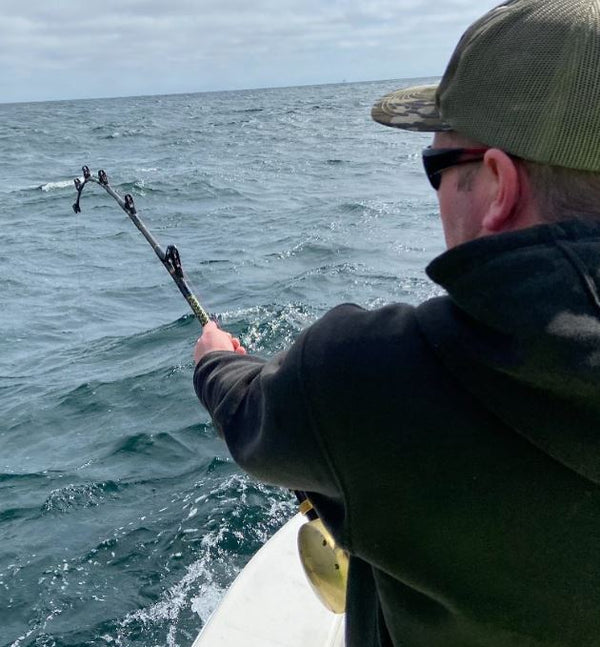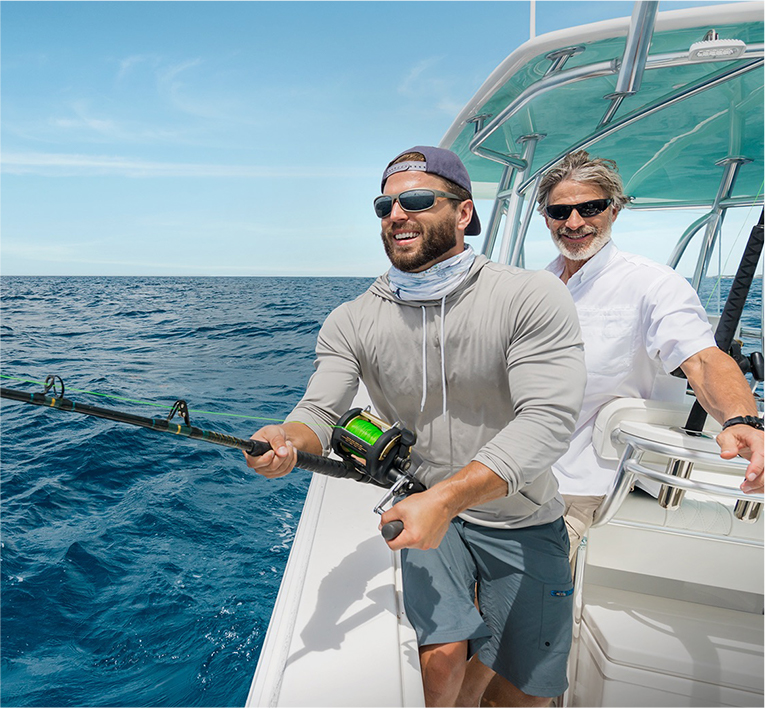Deep sea fishing reels are specialized fishing tools designed for handling the challenges of deep-sea fishing, featuring durable construction and high line capacity. These reels are popular among anglers due to their ability to handle large game fish found in deep offshore waters.
With their sturdy build, deep sea fishing reels offer the necessary strength and power to reel in hefty catches like marlin, tuna, and swordfish. The advanced drag systems and heavy-duty gears ensure smooth operation and prevent line breakage when battling strong and aggressive deep-sea species.
These reels often have a high gear ratio to retrieve line quickly, and they are usually made from corrosion-resistant materials to withstand the harsh marine environment. Whether you are an experienced angler or just starting, having the right deep-sea fishing reel will significantly enhance your chances of success when targeting big game fish in the depths.

Credit: www.coastalfishing.com
Introduction To Deep Sea Fishing Reels
Deep sea fishing reels are an essential tool for anglers who tackle the challenges of deep sea fishing. They play a significant role in landing large and powerful ocean game fish. If you’re new to deep sea fishing or simply want to expand your knowledge on the subject, this section will provide you with an introduction to deep sea fishing reels, their definition, and their role in angling.
Definition And Role Of Deep Sea Fishing Reels In Angling
- Deep sea fishing reels are sophisticated mechanical devices used to control the fishing line, allowing anglers to cast and retrieve their baits or lures effectively.
- These reels are specifically designed to handle the demanding conditions of offshore fishing, where larger and more aggressive fish species reside.
- Deep sea fishing reels offer increased line capacity, sturdy construction, heavy-duty drag systems, and powerful gear ratios to handle the extreme stress and resistance encountered in the deep sea.
- Their primary role is to provide anglers with the ability to control, retrieve, and fight against larger fish species commonly found in deep waters.
- Deep sea fishing reels come in various sizes and configurations to accommodate different fishing techniques, water depths, and target species.
- These reels are typically larger and more robust than their freshwater or inshore counterparts, allowing for the increased strength and durability necessary to withstand the harsh marine environment.
Overview Of The Different Types Of Fishing Reels
- Spinning reels: Spinning reels, also known as open-face reels, are one of the most popular types of fishing reels used in deep sea fishing. They offer easy casting and versatility, making them suitable for various fishing techniques.
- Conventional reels: Conventional reels, also called baitcasting or overhead reels, are commonly used for deep sea fishing due to their high line capacity and advanced drag systems. They provide enhanced control and power, making them ideal for targeting larger species.
- Electric reels: Electric reels are a game-changer in deep sea fishing. They feature motorized mechanisms that aid in line retrieval and can handle heavy deep dropping or deep jigging applications with minimal effort from the angler.
- Lever drag reels: Lever drag reels are specifically designed for offshore big game fishing. They offer precise drag settings, smoother operation, and increased line capacity, allowing anglers to battle with powerful predators like marlin, tuna, and sailfish.
- Offshore trolling reels: Offshore trolling reels are designed for trolling applications, where anglers drag their baits or lures behind a moving boat. These reels offer high line capacities and powerful drags to handle the stress of trolling large lures or live baits at high speeds.
Understanding the definition and role of deep sea fishing reels, as well as the different types available, is crucial for any angler venturing into the world of deep sea fishing. Whether you’re planning an offshore adventure or simply want to upgrade your gear for bigger challenges, choosing the right deep sea fishing reel will significantly enhance your chances of success and make the whole experience more enjoyable.
Key Features Of Deep Sea Fishing Reels
Understanding The Importance Of Durability And Strength
Deep sea fishing reels are specifically designed to withstand the harsh conditions and extreme forces that come with deep sea fishing. Durability and strength are key features that differentiate deep sea fishing reels from regular fishing reels. Here are some important points to understand about the role of durability and strength in deep sea fishing reels:
- Durability is crucial because deep sea fishing involves heavy-duty fishing techniques and targets larger and more powerful fish species. A durable reel can handle the intense pressure, weight, and constant exposure to saltwater that occurs during deep sea fishing expeditions.
- Strength is equally important as it determines the reel’s ability to handle heavy fishing lines and withstand powerful fish strikes. Deep sea fishing reels are built with sturdy materials and robust construction to ensure they have the strength to reel in big game fish without compromising functionality.
- When it comes to deep sea fishing, time spent on the water can be unpredictable. The ocean can be unforgiving and conditions can change rapidly. Having a durable and strong reel gives anglers the confidence to handle any situation that may arise, providing reliability and peace of mind.
- Investing in a high-quality deep sea fishing reel that is built to last can save you money in the long run. A durable reel that can withstand the harsh elements and rigorous demands of deep sea fishing will require less frequent repairs or replacements.
- The durability and strength of a deep sea fishing reel are often reflected in its construction materials such as high-grade aluminum, stainless steel, or carbon fiber. These materials contribute to the reel’s ability to withstand corrosion, impact, and stress, ensuring its longevity and performance.
Exploring The Various Components Of A Deep Sea Fishing Reel
Deep sea fishing reels consist of several components that work together to provide anglers with a powerful and reliable fishing tool. Understanding the various components and their functions can help you choose the right reel for your deep sea fishing adventures.
Let’s take a closer look at each component:
- Drag system: The drag system is one of the most important components of a deep sea fishing reel. It controls the amount of resistance applied to the fishing line when a fish pulls against it. A smooth and powerful drag system is essential for landing big game fish and preventing line breakage.
- Gear ratio: The gear ratio determines how many times the spool rotates for each turn of the reel handle. Deep sea fishing reels typically have high gear ratios, allowing for fast line retrieval when battling against strong and fast fish. Common gear ratios for deep sea fishing reels range from 4.5:1 to 6.3:1.
- Line capacity: Deep sea fishing often requires using thicker and heavier fishing lines to handle the weight and strength of the fish being targeted. The line capacity of a reel refers to the amount of fishing line it can hold. A deep sea fishing reel with higher line capacity allows for longer and stronger lines to be used.
- Ball bearings: Ball bearings reduce friction during the reel’s operation, providing smooth and effortless line retrieval. Deep sea fishing reels typically have a higher number of ball bearings to ensure smooth performance under heavy loads and increased durability.
- Frame and body: The frame and body of a deep sea fishing reel are typically made from strong and corrosion-resistant materials like aluminum or graphite. The design and construction of the frame and body play a crucial role in providing strength, stability, and longevity to the reel.
- Handle: The handle of a deep sea fishing reel allows anglers to retrieve the fishing line and control the reel’s operation. Handles are often ergonomically designed for comfort and may feature anti-slip grips to ensure a secure hold, even when wet.
- Spool: The spool holds the fishing line and determines how much line can be retrieved with each rotation of the handle. Deep sea fishing reels may feature large spools to accommodate thicker lines and increase line capacity.
By understanding the importance of durability and strength in deep sea fishing reels, as well as familiarizing yourself with the various components, you can make an informed decision when selecting a reel that suits your fishing needs. Remember to prioritize reliability, performance, and longevity to enhance your deep sea fishing experience.
Types Of Deep Sea Fishing Reels
Spinning Reels: A Versatile Option For Different Fish Species
Spinning reels are one of the most popular types of deep sea fishing reels, known for their versatility and ease of use. Whether you are targeting small or large fish species, spinning reels can handle the job with ease. Here are some key points to know about spinning reels:
- Spinning reels are designed to be user-friendly, making them a great option for beginners or those new to deep sea fishing.
- These reels feature a fixed spool that allows the line to spool off during casting, making them ideal for long-distance casting.
- They offer a high level of control and precision, allowing anglers to easily manipulate the line and make quick adjustments during battles with fish.
- Spinning reels are known for their smooth drag systems, which provide consistent pressure to tire out fish without risking line breakage.
- They are suitable for various fishing techniques, including casting lures, live bait, and bottom fishing.
- Spinning reels come in a wide range of sizes, so you can choose the appropriate model based on the size of the fish you are targeting.
Baitcasting Reels: Optimal For Heavy-Duty Deep Sea Fishing
Baitcasting reels are the go-to choice for anglers who want to tackle heavy-duty deep sea fishing. These reels are known for their robust construction and ability to handle large and powerful fish. Here’s what you need to know about baitcasting reels:
- Baitcasting reels excel in casting accuracy, making them ideal for targeting specific structures or areas where fish are known to gather.
- They offer a higher gear ratio compared to spinning reels, allowing for quick line retrieval and faster hook sets when a fish bites.
- Baitcasting reels are equipped with powerful drag systems, capable of stopping the most powerful fish in their tracks.
- These reels come in both single and dual-speed variations, allowing anglers to choose the right gear ratio for their fishing needs.
- Baitcasting reels require some skill and practice to master, as they can be more challenging to cast and control than spinning reels.
- They are ideal for deep sea fishing techniques such as trolling, jigging, and live bait fishing.
Electric Reels: The Future Of Deep Sea Fishing With Advanced Technology
Electric reels are revolutionizing the world of deep sea fishing with their advanced technology and convenience. These reels are perfect for anglers who want to take their fishing experience to the next level. Here are some key points about electric reels:
- Electric reels utilize powerful motors to assist with line retrieval, eliminating the need for hand cranking.
- They are particularly beneficial for anglers who may have physical limitations or struggle with the physical demands of deep sea fishing.
- Electric reels offer variable speed settings, allowing anglers to adjust the retrieval speed to match their fishing needs.
- These reels also feature advanced drag systems, ensuring optimal control and consistent pressure on fish during battles.
- Electric reels are suitable for various fishing techniques, including deep dropping, kite fishing, and offshore trolling.
- While electric reels may come with a higher price tag, their convenience and efficiency make them a worthy investment for serious deep sea anglers.
Deep sea fishing reels come in different types, each catering to specific fishing needs and preferences. Whether you opt for a versatile spinning reel, heavy-duty baitcasting reel, or advanced electric reel, choosing the right one will enhance your deep sea fishing experience.
So, consider your fishing style, target species, and level of expertise when selecting the perfect deep sea fishing reel for your next adventure.
Factors To Consider When Choosing A Deep Sea Fishing Reel
When it comes to choosing a deep sea fishing reel, there are several factors that you need to consider. From understanding the fishing conditions and target species to evaluating drag strength and gear ratio, these considerations will play a crucial role in ensuring a successful deep sea fishing experience.
Additionally, the reel size, weight, and ease of use also contribute to the overall comfort and efficiency while out on the open sea. Let’s take a closer look at each of these factors:
Understanding The Fishing Conditions And Target Species
- Different fishing conditions require different types of reels, so it’s important to assess the environment you’ll be fishing in. Factors such as water depth, current strength, and bottom terrain will influence the type of reel you need.
- The target species also determine the type of reel and its features. For example, larger species may require reels with higher line capacities and stronger drags to handle their strength.
Evaluating Drag Strength And Gear Ratio For Successful Deep Sea Fishing
- Drag strength is one of the most critical factors in deep sea fishing reels. It determines the resistance the reel can apply to the line, allowing you to control the fish during the fight. Look for reels with strong and smooth drag systems that can handle the power of deep sea species.
- Gear ratio refers to the number of times the spool rotates with each turn of the handle. For deep sea fishing, a higher gear ratio (5: 1 or more) is preferred as it allows for faster line retrieval, especially when dealing with large and powerful fish.
Considering Reel Size, Weight, And Ease Of Use For Comfort And Efficiency
- Reel size should match the fishing rod and the line capacity required for your fishing needs. A larger reel with a higher line capacity is generally recommended for deep sea fishing.
- The weight of the reel is crucial, as you’ll be holding it for extended periods. Opt for lighter reels that offer a good balance between strength and comfort.
- Ease of use is essential when battling tough fish. Look for reels with ergonomic designs, comfortable handles, and smooth operation to prevent fatigue during long fights.
Remember, these factors should guide your decision when choosing a deep sea fishing reel. By considering the fishing conditions, target species, drag strength, gear ratio, reel size, weight, and ease of use, you’ll be well-equipped for an enjoyable and successful deep sea fishing expedition.
Happy fishing!
Maintenance And Care For Deep Sea Fishing Reels
Deep sea fishing reels are essential tools for any angler seeking to tackle the challenges of offshore fishing. These robust reels are designed to withstand the powerful forces encountered in deep waters, but they still require proper maintenance and care to ensure optimal performance and longevity.
In this section, we will explore some key steps you can take to keep your deep sea fishing reels in top shape.
Cleaning And Lubricating The Reel For Optimal Performance:
Proper cleaning and regular lubrication are crucial for maintaining the smooth operation of your deep sea fishing reel. Here are some key points to keep in mind:
- Rinse after every use: After each fishing trip, make sure to rinse your reel with freshwater to remove salt, sand, and other debris that may have accumulated. Pay special attention to the reel’s internal components and moving parts.
- Use a soft brush: Gently scrub the reel’s exterior and hard-to-reach areas using a soft brush or toothbrush. This helps remove any stubborn dirt or grime without causing damage to the reel’s finish. Be cautious around sensitive areas like drag washers and the line roller.
- Inspect and lubricate: Regularly inspect the reel’s internal components for signs of wear or damage. Apply a small amount of reel oil or grease to the gears, bearings, and other moving parts to maintain smooth operation. Avoid over-lubricating, as excessive lubrication can attract dirt and impede performance.
- Reel maintenance kits: Consider investing in a reel maintenance kit, which typically includes the necessary cleaning agents, lubricants, and tools needed to properly maintain your deep sea fishing reel. These kits make the maintenance process more convenient and ensure you have the correct products for the job.
Proper Storage And Transportation To Prevent Damage:
Proper storage and transportation of your deep sea fishing reel are vital to prevent unnecessary damage. Here are a few important tips:
- Clean and dry before storage: Before storing your reel, ensure it is clean, dry, and free from any saltwater or dirt that may have accumulated during your fishing trip. This helps prevent corrosion and damage to the reel’s components.
- Store in a cool, dry place: Find a cool and dry storage location for your fishing reel. Extreme temperatures and humidity can be detrimental to its performance and lifespan. Avoid exposing the reel to direct sunlight or leaving it in an area where moisture may accumulate.
- Protective cases and bags: Consider using a protective reel case or bag during transportation to shield your reel from accidental bumps, scratches, and exposure to the elements. These cases provide an added layer of protection and ensure your reel remains in optimal condition during transit.
Regular Inspection And Maintenance To Prolong The Reel’S Lifespan:
To extend the lifespan of your deep sea fishing reel and ensure consistent performance, regular inspection and maintenance are essential. Follow these key points:
- Inspect for wear and tear: Regularly inspect your reel for any signs of wear, such as loose parts, frayed lines, or worn-out drag washers. Address these issues promptly to prevent further damage or potential malfunctions while out on the water.
- Replace worn-out parts: If you notice any worn-out or damaged parts during inspection, such as bearings or drag washers, consider replacing them with high-quality replacements. This will help maintain the reel’s performance and prevent potential failures during fishing trips.
- Follow manufacturer’s guidelines: Read and familiarize yourself with the manufacturer’s guidelines specific to your deep sea fishing reel. This ensures you follow the recommended maintenance procedures and use compatible cleaning agents and lubricants. Adhering to these guidelines will optimize your reel’s performance and longevity.
By following these maintenance and care practices, you can keep your deep sea fishing reels in excellent working condition for years to come. Take the time to clean, lubricate, store, and inspect your reel regularly, and you’ll be rewarded with smooth casts, powerful retrieves, and memorable deep sea fishing experiences.
So, gear up, hit the waters, and enjoy the thrills of deep sea fishing with a well-maintained reel at your side.
Tips And Techniques For Deep Sea Fishing With Reels
Mastering The Art Of Casting And Reeling In Deep Sea Fishing
Deep sea fishing requires skill and technique, especially when it comes to casting and reeling in. To ensure a successful and enjoyable fishing experience, here are some tips and techniques to help you master the art of casting and reeling in deep sea fishing:
- Utilize the proper equipment: Invest in a high-quality deep sea fishing reel that is designed to handle the strong currents and large fish commonly found in deep waters.
- Practice your casting technique: Before heading out to sea, take the time to practice your casting technique. Focus on your accuracy and distance, as these factors are crucial when trying to hook a fish in deep waters.
- Use the appropriate bait: Different fish species are attracted to different types of bait. Research the fish you are targeting and select the appropriate bait to increase your chances of success.
- Cast with precision: When casting your line, aim for specific locations such as rocky areas, reefs, or underwater structures where fish tend to gather. This precision can significantly increase your chances of hooking a fish.
- Be patient: Deep sea fishing requires patience. Cast your line and wait for the fish to bite. Avoid reeling in too quickly or constantly re-casting, as this can scare away potential catches.
- Master the art of reeling in: Once you’ve hooked a fish, the real challenge begins. Use a smooth and steady reeling motion to bring the fish closer to the boat. Avoid jerking or yanking the reel, as this can cause the fish to break loose.
- Maintain tension on the line: Keep a constant tension on the line while reeling in the fish to prevent it from shaking the hook loose. This requires a delicate balance of applying pressure without overpowering the fish.
- Adjust your drag system accordingly: The drag system on your reel plays a crucial role in controlling the fish. If the fish is putting up a strong fight, gradually increase the drag to tire it out. Conversely, if the fish is running in the opposite direction, loosen the drag to prevent the line from breaking.
Remember, mastering the art of casting and reeling in deep sea fishing takes time and practice. With these tips and techniques, you’ll be well on your way to becoming a skilled angler in the deep waters.
Using The Drag System Effectively For Controlling The Fish
When it comes to deep sea fishing, effectively using the drag system on your reel is crucial for controlling the fish and ensuring a successful catch. Here are some tips on how to use the drag system effectively:
- Understand how the drag system works: Familiarize yourself with the drag system on your reel, as the mechanics may vary depending on the type of reel you are using. Ensure that you know how to adjust the drag and set it to the appropriate level.
- Start with a lower drag setting: When you initially hook a fish, start with a lower drag setting to prevent the line from breaking. This will also allow the fish to run if it’s putting up a fight.
- Gradually increase the drag: As the fish tires out, gradually increase the drag to apply more pressure. This will make it harder for the fish to escape, ultimately increasing your chances of reeling it in.
- Don’t overpower the fish: While it’s important to assert control over the fish, it’s equally important not to overpower it. Applying too much pressure can cause the line to snap or the hook to dislodge, resulting in a lost catch.
- Be mindful of the fish’s behavior: Pay close attention to the fish’s movements and adjust the drag accordingly. If the fish is making powerful runs, loosen the drag slightly to avoid line breakage. Conversely, if the fish starts to slow down, tighten the drag to gain more control.
- Avoid sudden changes in drag setting: To prevent any sudden shock to the line or fish, make adjustments to the drag system gradually. Sudden changes can startle the fish and lead to it pulling away or breaking loose.
By effectively using the drag system on your reel, you’ll be able to maintain control over the fish throughout the deep sea fishing experience and increase your chances of landing that prized catch.
Techniques For Handling And Fighting Large Fish In Deep Waters
When it comes to deep sea fishing, tackling and fighting with large fish can be quite challenging. To ensure your success and minimize the risk of losing a catch, here are some techniques for handling and fighting large fish in deep waters:
- Get a firm grip: When reeling in a large fish, ensure that you have a secure and firm grip on the rod. Keep your hands positioned correctly to maintain control and prevent the fish from pulling away.
- Use your entire body: Use your body weight and strength to help reel in the fish. Brace your feet firmly and engage your core muscles to take some of the strain off your arms.
- Play the fish: Allow the fish to tire itself out by playing it. This involves using the drag system effectively and allowing the fish to run while slowly reeling it in. Avoid trying to overpower the fish right from the start, as this can lead to breakage or lost catches.
- Avoid jerking the rod: Jerking the rod can cause the fish to dislodge the hook or break the line. Maintain a smooth and steady reeling motion, applying consistent pressure to gradually bring the fish closer to the boat.
- Use your rod as a shock absorber: When the fish makes sudden powerful runs, use your rod as a shock absorber to minimize the strain on the line. Allow the rod to bend and flex while maintaining tension on the line to prevent it from breaking.
- Be patient and persistent: Fighting with large fish in deep waters can take time and require patience. Stay focused, be persistent, and avoid rushing the process. With regular practice and determination, you’ll improve your skills in handling and successfully landing large fish.
By applying these techniques, you’ll be better equipped to handle and fight large fish in deep waters. Remember, practice makes perfect, so don’t be discouraged if it takes some time to master these skills. Keep honing your abilities, and you’ll soon experience the thrill of landing that trophy fish in the deep sea.
Conclusion
Deep sea fishing reels are essential tools for anyone looking to venture into the depths of the ocean in search of big game fish. These powerful and durable reels are specially designed to handle the harsh conditions encountered in deep-sea fishing.
With their advanced features and technology, they provide the strength and control needed to reel in even the largest catches. From lever drags to spinning reels, there are a variety of options to choose from, each with its own unique advantages.
Whether you’re a professional angler or a recreational fisherman, investing in a high-quality deep sea fishing reel is a must. Not only will it enhance your fishing experience, but it will also increase your chances of landing that trophy fish.
So, equip yourself with the right reel, gear up, and get ready for an unforgettable deep-sea fishing adventure!






